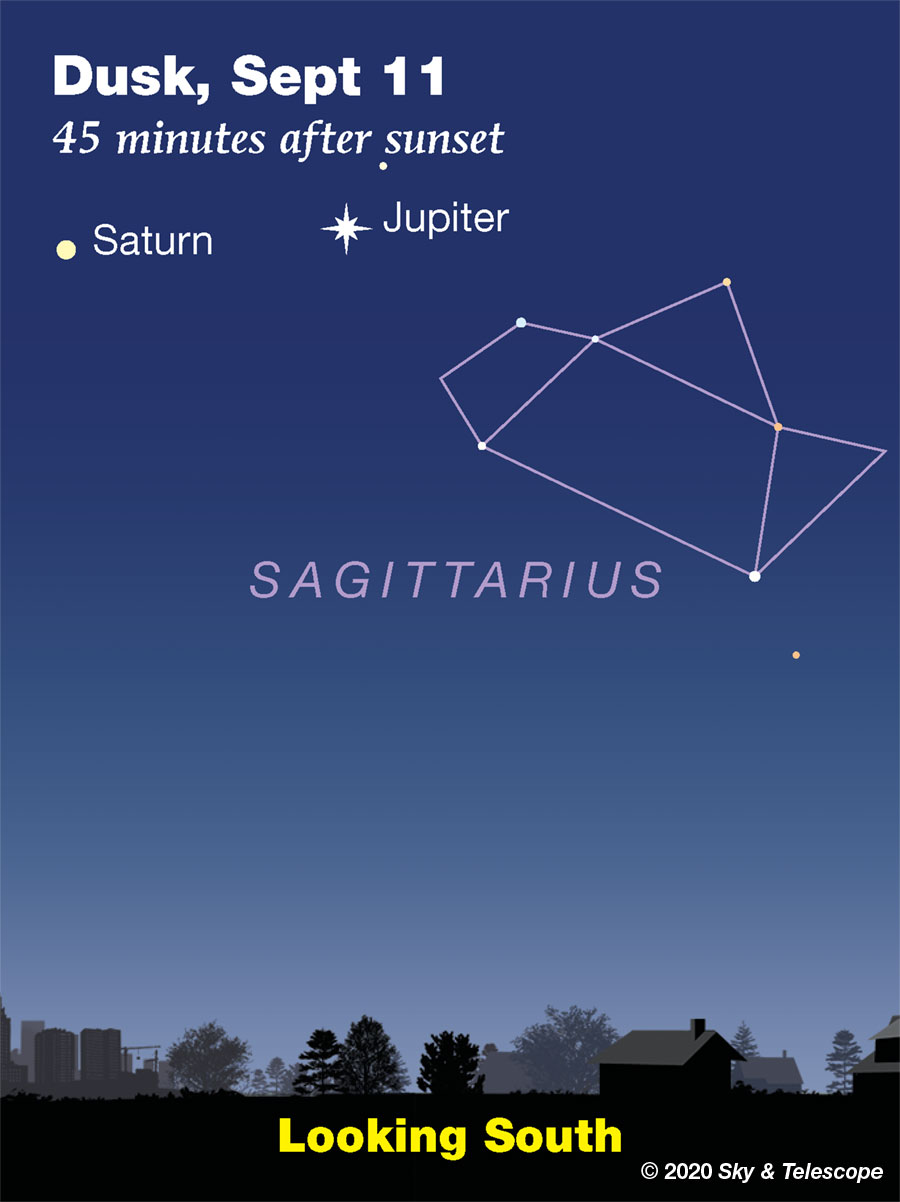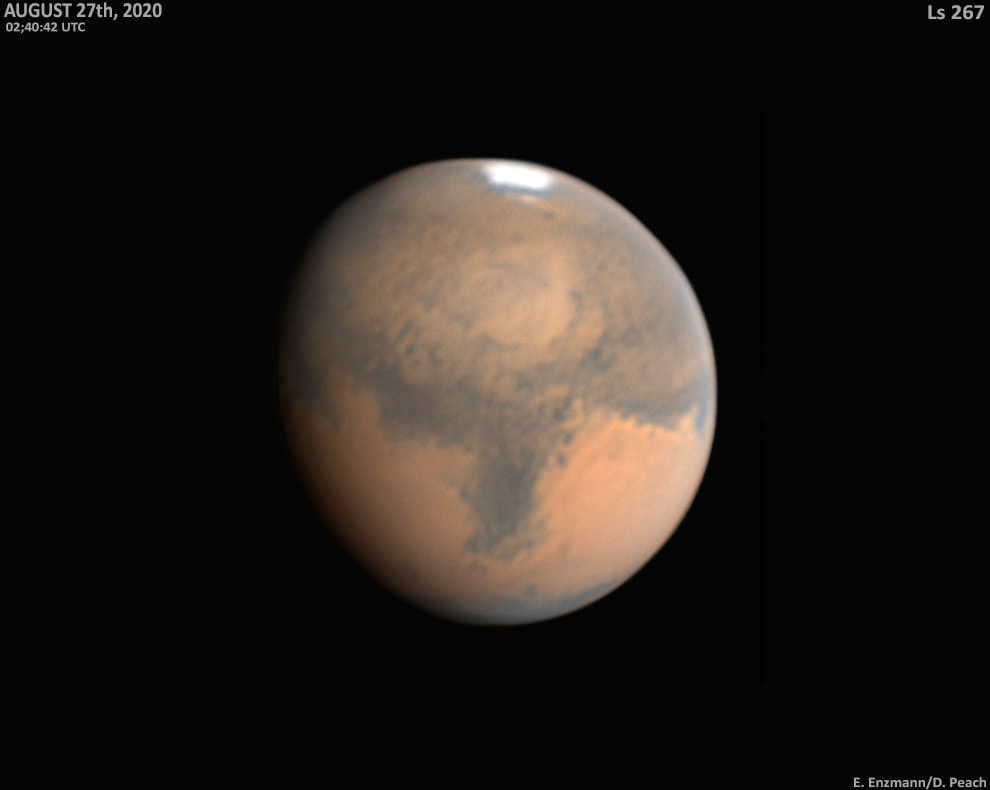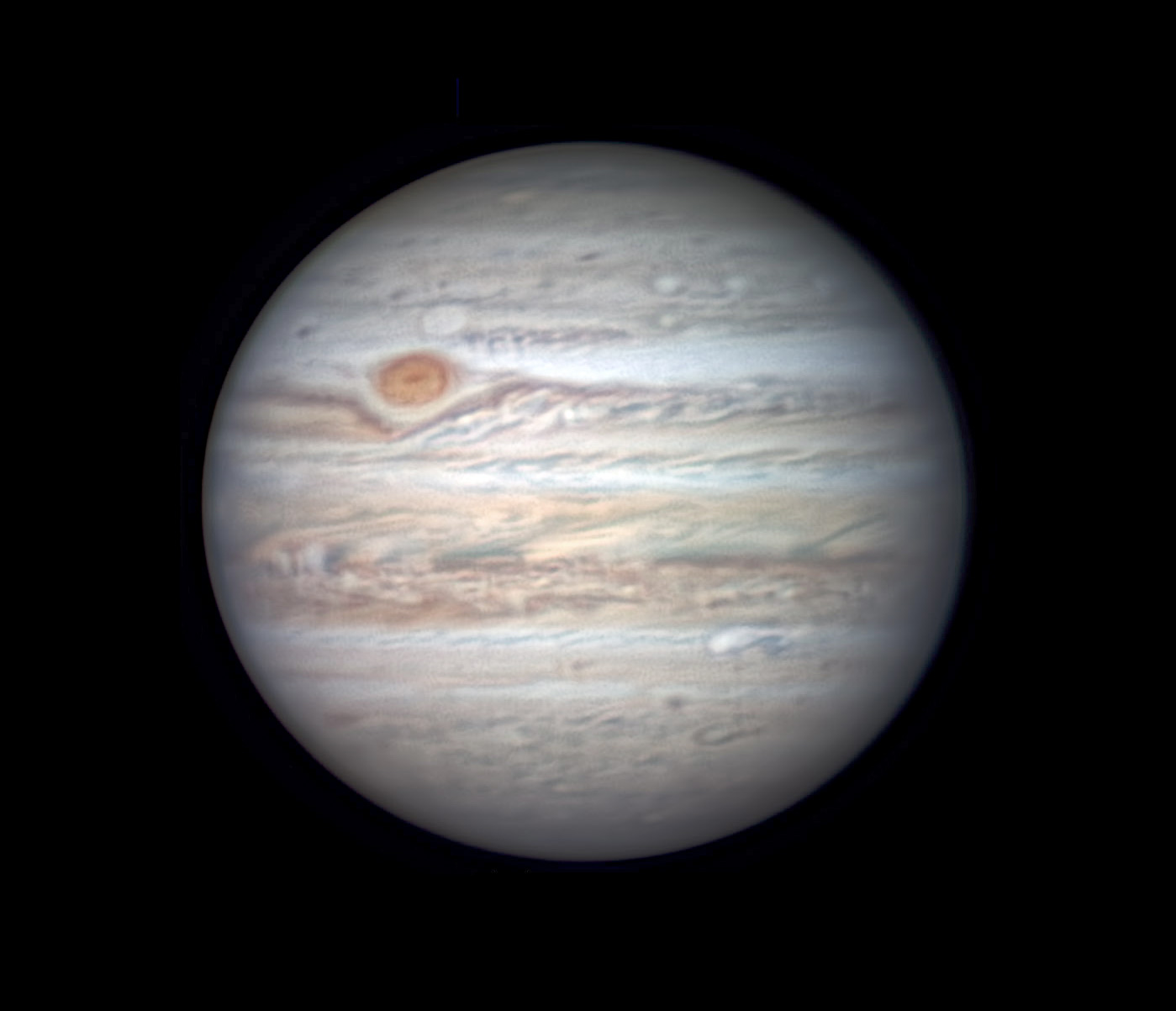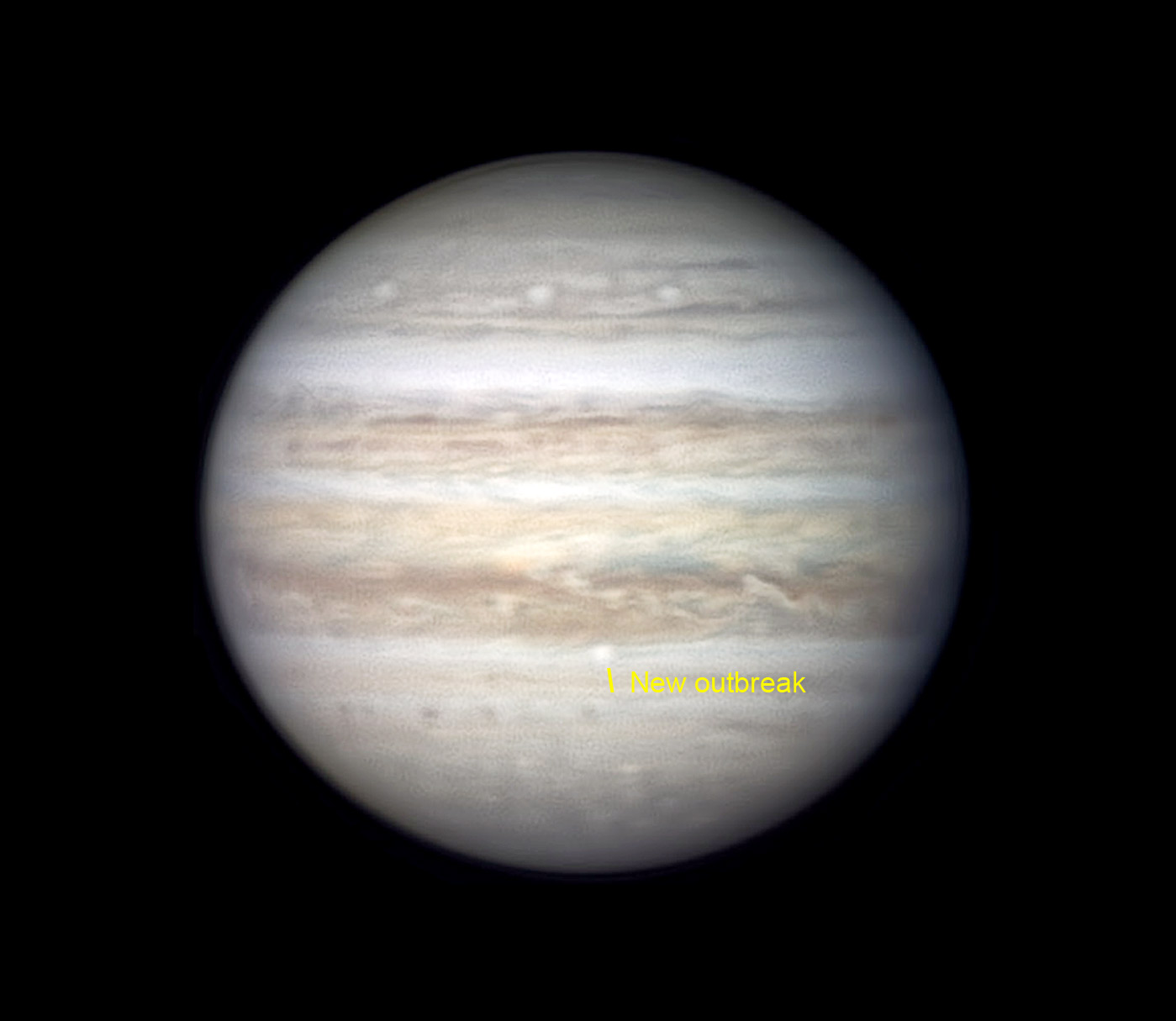FRIDAY, SEPTEMBER 11
■ Jupiter and Saturn continue shining in the south at dusk. They turn horizontal during twilight, then tilt to the right as evening advances. They set in the southwest around 1 a.m.

■ Vega passes the zenith about an hour after sunset (during late twilight) for those of us at mid-northern latitudes. Vega is bigger, hotter, and 50 times brighter than the Sun. But at a distance of 25 light-years, it's 1.6 million times farther away. (The Sun is 8.3 light-minutes from Earth.)
Whenever Vega passes closest to overhead, the entire sky panorama above the horizon is that of the Vega Hour, in Fred Schaaf's poetic terminology. He tours you all around the sky geography of the Vega Hour in the September Sky & Telescope, page 45.
■ Neptune is at opposition.
SATURDAY, SEPTEMBER 12
■ By 9 or 10 p.m. two of the best-known deep-sky objects, the Double Cluster in Perseus and the Great Andromeda Galaxy M31, are in high view in the east. They're only 22° apart. They're both cataloged as 4th magnitude but to the naked eye they look rather different, the more clearly so the darker your sky. See for yourself. They're plotted on the all-sky constellation map in the center of the September Sky & Telescope, which should be all the map you need to identify their locations. They're below Cassiopeia and farther to Cassiopeia's right, respectively. Sky too bright? Use binoculars!
The two clusters of the Double Cluster (NGC 869 and NGC 884) are both about 7,600 light-years away. M31, at 2.5 million light-years, is about 330 times farther.
■ Jupiter's Great Red Spot should transit Jupiter's central meridian around 11:05 p.m. Eastern Daylight Time; 8:05 Pacific.
SUNDAY, SEPTEMBER 13
■ Venus and the waning crescent Moon pair up in the east before and during dawn. They're about 5° apart at the times of dawn for North America.
If you catch them before dawn begins (look at least 1 hour 30 minutes before your local sunrise) and use binoculars, there will be the Beehive Star Cluster, M44, about 2½° to Venus's upper left.
■ How well do you really know the Ring Nebula in Lyra? In early evening it's now nearly straight overhead, in probably the darkest part of your sky. Explore its subtleties with Howard Banich's Going Deep column in the September Sky & Telescope, starting on page 58.
And explore the outstretched hand of Andromeda, including the Blue Snowball nebula, a subtle galaxy, and several nice double stars, starting on page 62.
MONDAY, SEPTEMBER 14
■ The Great Square of Pegasus is high in the east after dark, balancing on one corner.
From the Great Square's left corner extends a big line of three 2nd-magnitude stars, running to the lower left, that mark the head, backbone and leg of the constellation Andromeda. (She's seen in profile. The line of three includes the Square's left corner, her head.)
Upper left from the foot of this line, you'll find W-shaped Cassiopeia tilting up.
TUESDAY, SEPTEMBER 15
■ Jupiter's Great Red Spot should transit Jupiter's central meridian around 8:36 p.m. Eastern Daylight Time. Just 11 minutes later, the tiny black shadow of Io starts to cross Jupiter's face, entering the eastern limb. Then at 9:51 p.m. EDT, Io itself emerges from transit, budding off from Jupiter's western limb.
■ Most variable stars for amateur telescopes take days to weeks to change brightness noticeably. But the fastest eclipsing binary stars can change detectably in 10 minutes. A selection of such fast, deep eclipsers, with finder charts, await you and your scope in Bob King's article Take a Roller Coaster Ride on a Fast Eclipsing Binary.
Years ago, I would spend hours through a quiet night carefully noting the changing magnitude of some such faint star for the AAVSO's Eclipsing Binary Section. I was using a homemade 6-inch reflector on my parents' lawn with just my eye and an AAVSO comparison-star chart, having planned things out with a list of eclipse predictions. The purpose was, and is, to track any slight drifts in the times of mid-eclipse from the predicted times, indicating tiny changes in the stars' orbital period across months or years. Such changes can reveal mass exchanges either steady or sudden; the influence of an unseen, third orbiting companion; changes intrinsic to one of the stars, or other effects.
Nowadays amateurs do this with greater precision and reliability using electronic imaging. But for me, that visual program was really what turned me into a serious amateur astronomer.
WEDNESDAY, SEPTEMBER 16
■ With the evenings moonless, this is a great week for the Milky Way under a dark sky. When Deneb crosses your zenith (two hours after Vega; around 10 p.m. now), the Milky Way does too — running straight up from the southwest horizon and straight down to the northeast horizon.
THURSDAY, SEPTEMBER 17
■ Jupiter's Great Red Spot should transit the planet's central meridian around 10:14 p.m. EDT.
■ New Moon (exact at 7:00 a.m. EDT).
FRIDAY, SEPTEMBER 18
■ You can see in the stars that the season is changing; we've reached the time of year when, just after nightfall, Cassiopeia has already climbed a little higher in the northeast than the Big Dipper has sunk in the northwest. Cas stands high in early evening during the chilly fall-winter half of the year. The Big Dipper takes over for the milder evenings of spring and summer.
Almost midway between them stands Polaris. It's currently a little above the midpoint between the two.
SATURDAY, SEPTEMBER 19
■ Arcturus, the "Spring Star," shines a little lower in the west after dark every week as summer turns to fall. (The September equinox is next Tuesday.) The narrow, kite-shaped pattern of Bootes extends 24° upper right from Arcturus.
This Week's Planet Roundup
Mercury is having a very low, poor apparition deep in the sunset. At least it's fairly bright at magnitude –0.2 this week, so go ahead and try. Bring binoculars. About 20 minutes after sunset, while twilight is still bright, start scanning for it just above the horizon about 15° left of due west. Good luck!
Venus (magnitude –4.2, in dim Cancer) rises in deep darkness two hours before dawn begins, in the east-northeast about 20° below Pollux and Castor. By the time dawn gets under way, Venus shines fairly high in the east.
To Venus's upper right is Procyon. Venus and Procyon form a nearly equilateral triangle with Pollux above.
Right or lower right of Procyon shines brighter Sirius. It's the brightest star but nowhere near a match for Venus.
In a telescope, Venus continues to shrink slowly into the distance; it's now about 18 arcseconds in diameter. And as it rounds toward passing behind the Sun next winter it's becoming more gibbous; it's now 65% sunlit.
Mars shines big, bright and close as it approaches its October 13th opposition! It will pass closest by Earth on October 6th. This week it rises in the east around the end of twilight — shining bright orange at magnitude –2.2, almost Jupiter-bright. Mars climbs higher through the evening and stands at its highest and telescopic best around 3 a.m. daylight-saving time, beaming down on the world from high in the south. It's near the dim (4th-magnitude) Knot of Pisces.
Mars is already 21 arcseconds in apparent diameter, practically as big as it will be when passing closest by Earth (22.6 arcseconds). It's becoming less gibbous (95% sunlit) as approaches "full Mars" at opposition. Look for its white South Polar Cap, now much shrunken as summer advances in Mars's southern hemisphere. There may or may not be any whitish patches of cloud; this seems to be a clear season on Mars.
But Mars's dusky surface markings are the eternal attraction. To get a map of the side facing Earth at the date and time you'll observe, you can use our Mars Profiler. The map there is square; remember to mentally wrap it onto the side of a globe. (Features near the map's edges become very foreshortened.)

The South Polar Cap continues to shrink, and just off its edge, only a little remains of Novus Mons. In an image Enzmann and Peach took just six days earlier, the Novus Mons patch was longer, sharply defined, and starkly white.
Jupiter and Saturn (magnitudes –2.5 and +0.4, respectively) shine in the south in early evening and move to the southwest later in the night. Jupiter is the brightest. Saturn remains 8° to its left.
Very high above them shines Altair: white-hot, 11 times as luminous as the Sun, and just 17 light-years away.
Much closer below Jupiter after dark is the handle of the Sagittarius Teapot. The brightest star of the handle (the top one) is Sigma Sagittarii or Nunki, magnitude 2.0. It's an even hotter blue-white star, 4.5 times the Sun's diameter, 3300 times as luminous, and 230 light-years away.
Telescopically, there's a lot happening on Jupiter now; see Bob King's Stormy Times on Jupiter. And follow the interplay of Jupiter with its moons and their shadows, and find the transit times of Jupiter's Great Red Spot, in the Celestial Calendar section of the September Sky & Telescope, page 50.


Uranus (magnitude 5.7, in Aries) is fairly well up in the east by 11 p.m. daylight-saving time, about 12° east of Mars.
Neptune (magnitude 7.8, in Aquarius) is higher in the south-southeast by that time. It's at opposition on September 11. Finder charts for Uranus and Neptune.
All descriptions that relate to your horizon — including the words up, down, right, and left — are written for the world's mid-northern latitudes. Descriptions that also depend on longitude (mainly Moon positions) are for North America.
Eastern Daylight Time, EDT, is Universal Time (also known as UT, UTC, GMT, or Z time) minus 4 hours.
Want to become a better astronomer? Learn your way around the constellations. They're the key to locating everything fainter and deeper to hunt with binoculars or a telescope.
This is an outdoor nature hobby. For an easy-to-use constellation guide covering the whole evening sky, use the big monthly map in the center of each issue of Sky & Telescope, the essential magazine of astronomy.
Once you get a telescope, to put it to good use you'll need a detailed, large-scale sky atlas (set of charts). The basic standard is the Pocket Sky Atlas (in either the original or Jumbo Edition), which shows stars to magnitude 7.6.

Next up is the larger and deeper Sky Atlas 2000.0, plotting stars to magnitude 8.5; nearly three times as many. The next up, once you know your way around, are the even larger Interstellarum atlas (stars to magnitude 9.5) or Uranometria 2000.0 (stars to magnitude 9.75). And read how to use sky charts with a telescope.
You'll also want a good deep-sky guidebook, such as Sky Atlas 2000.0 Companion by Strong and Sinnott, or the bigger (and illustrated) Night Sky Observer's Guide by Kepple and Sanner.
Can a computerized telescope replace charts? Not for beginners, I don't think, and not on mounts and tripods that are less than top-quality mechanically, meaning heavy and expensive. And as Terence Dickinson and Alan Dyer say in their Backyard Astronomer's Guide, "A full appreciation of the universe cannot come without developing the skills to find things in the sky and understanding how the sky works. This knowledge comes only by spending time under the stars with star maps in hand."
![]() Audio sky tour. Out under the evening sky with your
Audio sky tour. Out under the evening sky with your
earbuds in place, listen to Kelly Beatty's monthly
podcast tour of the heavens above. It's free.
"The dangers of not thinking clearly are much greater now than ever before. It's not that there's something new in our way of thinking, it's that credulous and confused thinking can be much more lethal in ways it was never before."
— Carl Sagan, 1996
"Facts are stubborn things."
— John Adams, 1770
 6
6








Comments
mary beth
September 11, 2020 at 1:33 pm
Rod - hope you’re having a nice patriot day. God bless America. Question for you! I figured you could explain it better than a lot of people...How are star magnitudes measured? Obviously zero magnitude is derived from a standard source (??) since there are negatives which are brighter and positives which are less bright. Kind of confusing. Feel like taking this on?
You must be logged in to post a comment.
Rod
September 11, 2020 at 7:53 pm
mary beth, interesting question about magnitude measured in V band or visual light band. FYI. I worked in the Pentagon during the 911 attack and was there working in the Army Operations Center for the Army G3 when we stood by the CAT team and went to war. I retired from Federal civilian service in early Jan-2016. Star magnitudes are covered nicely by Jean Meeus Astronomical Algorithms book. It is a log scale algorithm that you can use to convert from a star's absolute magnitude to apparent magnitude and show the distance too (inverse square law of light). I put in the formulas into my trusty, MS astronomical spreadsheet. Absolute magnitude is the apparent magnitude of the star at a distance of 10 pc from Earth. Red giants with luminosity class III commonly have absolute magnitudes of Mv - 0.2, the Sun is +4.82. The base is 2.512^x for the calculations. A red giant absolute magnitude could be 109 brighter than the Sun at 10 pc distance. Zero on the scale or mv 0 compared to mv +5.0, mv 0 is 100x brighter than a star with +5 value on the scale or 2.512^5. There are ways to compare - and + values, show the brightness difference, and estimate distance too, using anti-log conversions. Stellarium will do this for you though :). If you click on a particular star, over on the left side you will get an ephemeris showing the star's distance, apparent magnitude, absolute magnitude, and stellar parallax and much more info, same for planets in the solar system 🙂 mary beth, this is the quick method to check. I use Stellarium all the time and check.
You must be logged in to post a comment.
mary beth
September 12, 2020 at 11:39 pm
Wow...thank you So much Rod for all this great information! I copie this into my IPhone notepad so I can look at it anytime. I really appreciate you taking the time to explain it so well. I need to read it several times to get a good understanding. I need to look up some of the words such as parallax. Just curious as to what your degree is in.... You obviously are very scientific!
Interesting about your experience on September 11. truly an unbelievable day.
You must be logged in to post a comment.
New Jersey Eclipse Fan
September 12, 2020 at 11:53 pm
Wow. Things sure have come a long way since I learned OBAFGKM in high school astronomy class. I'm sure my teacher, Mr. Negley, wasn't the only one to use the mnemonic Oh Be A Fine Girl Kiss Me, but I don't think that would fly these days.
You must be logged in to post a comment.
Rod
September 13, 2020 at 12:45 am
mary beth, New Jersey Eclipse Fan. I just came back in from Mars observing using my 90-mm refractor telescope at 129x to 200x views. Some really good views now, especially using #23A red filter. Various dark surface features quite visible and the south polar cap is distinct but smaller now. mary beth, I have a AA in business. I study independently in astronomy and learn some of the math. OBAFGKM is still good for most of the H-R star diagram plots and I learned it the old school saying too :). Now we have OBAFGKMLTY, http://www.astronomy.ohio-state.edu/~pogge/Ast1101/mnemonic.html
You must be logged in to post a comment.
New Jersey Eclipse Fan
September 13, 2020 at 8:18 pm
LOL. How about "Oh Be A Fine Girl/Guy Kiss My Lips To Yours"?
You must be logged in to post a comment.
You must be logged in to post a comment.